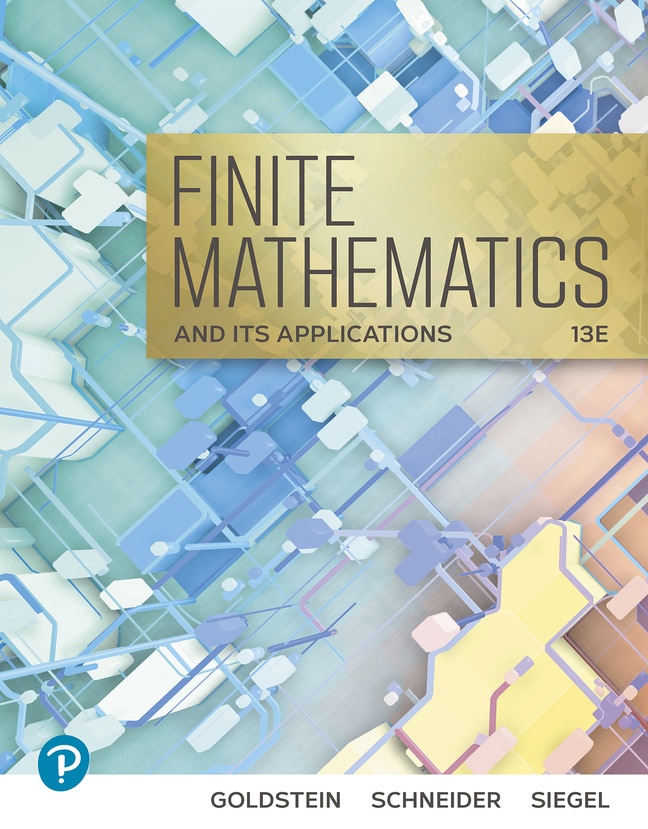
Finite Mathematics & Its Applications, 13th edition
- Larry J. Goldstein
- , David I. Schneider
- , Martha J. Siegel

- Find it fast
Quickly navigate your eTextbook with search
- Stay organized
Access all your eTextbooks in one place
- Easily continue access
Keep learning with auto-renew
Finite Mathematics and Its Applications, 13th Edition is packed with everyday applications like consumer loans, IRAs and mortgages to give you a solid foundation in math for future courses, careers and daily life. Built-in instruction on the latest technology incorporates graphing calculators, spreadsheets and Wolfram|Alpha®. Thousands of well-crafted exercises enable a wide range of practice in skills, applications, concepts and technology. This adaptable, student-oriented approach enables independent learning and study, while demonstrating how concepts apply to future careers.
Published by Pearson (January 7th 2022) - Copyright © 2023
ISBN-13: 9780137616664
Subject: Finite Math & Applied Calculus
Category: Finite Math
PART ONE
- Linear Equations and Straight Lines
- 1.1 Coordinate Systems and Graphs
- 1.2 The Slope of a Line
- 1.3 The Intersection Point of a Pair of Lines
- 1.4 The Method of Least Squares
- Chapter Summary and Chapter Review Exercises
- Chapter Project: Break-Even Analysis
- Matrices
- 2.1 Systems of Linear Equations with Unique Solutions
- 2.2 General Systems of Linear Equations
- 2.3 Arithmetic Operations on Matrices
- 2.4 The Inverse of a Matrix
- 2.5 The Gauss-Jordan Method for Calculating Inverses
- 2.6 Input-Output Analysis
- Chapter Summary and Chapter Review Exercises
- Chapter Project: Population Dynamics
- Linear Programming, A Geometric Approach
- 3.1 Linear Inequalities
- 3.2 A Linear Programming Problem
- 3.3 Fundamental Theorem of Linear Programming
- 3.4 Linear Programming
- Chapter Summary and Chapter Review Exercises
- Chapter Project: Shadow Prices
- The Simplex Method
- 4.1 Slack Variables and the Simplex Tableau
- 4.2 The Simplex Method I: Maximum Problems
- 4.3 The Simplex Method II: Nonstandard and Minimum Problems
- 4.4 Sensitivity Analysis and Matrix Formulations of Linear Programming Problems
- 4.5 Duality
- Chapter Summary and Chapter Review Exercises
- Chapter Project: Shadow Prices Revisited
PART TWO
- Sets and Counting
- 5.1 Sets
- 5.2 A Fundamental Principle of Counting
- 5.3 Venn Diagrams and Counting
- 5.4 The Multiplication Principle
- 5.5 Permutations and Combinations
- 5.6 Further Counting Techniques
- 5.7 The Binomial Theorem
- 5.8 Multinomial Coefficients and Partitions
- Chapter Summary and Chapter Review Exercises
- Chapter Project: Pascal's Triangle
- Probability
- 6.1 Experiments, Outcomes, Sample Spaces, and Events
- 6.2 Assignment of Probabilities
- 6.3 Calculating Probabilities of Events
- 6.4 Conditional Probability and Independence
- 6.5 Tree Diagrams
- 6.6 Bayes' Theorem, Natural Frequencies
- 6.7 Simulation
- Chapter Summary and Chapter Review Exercises
- Chapter Project: Two Paradoxes
- Probability and Statistics
- 7.1 Visual Representations of Data
- 7.2 Frequency and Probability Distributions
- 7.3 Binomial Trials
- 7.4 The Mean
- 7.5 The Variance and Standard Deviation
- 7.6 The Normal Distribution
- 7.7 Normal Approximation to the Binomial Distribution
- Chapter Summary and Chapter Review Exercises
- Chapter Project: An Unexpected Expected Value
PART THREE
- Markov Processes
- 8.1 The Transition Matrix
- 8.2 Regular Stochastic Matrices
- 8.3 Absorbing Stochastic Matrices
- Chapter Summary and Chapter Review Exercises
- Chapter Project: Doubly Stochastic Matrices
- The Theory of Games
- 9.1 Games and Strategies
- 9.2 Mixed Strategies
- 9.3 Determining Optimal Mixed Strategies
- Chapter Summary and Chapter Review Exercises
- Chapter Project: Simulating The Outcomes of Mixed-Strategy Games
PART FOUR
- The Mathematics of Finance
- 10.1 Interest
- 10.2 Annuities
- 10.3 Amortization of Loans
- 10.4 Personal Financial Decisions
- 10.5 A Unifying Equation
- Chapter Summary and Chapter Review Exercises
- Chapter Project: Two Items of Interest
- Logic
- 11.1 Introduction to Logic
- 11.2 Truth Tables
- 11.3 Implication
- 11.4 Logical Implication and Equivalence
- 11.5 Valid Argument
- 11.6 Predicate Calculus
- 11.7 Logic Circuits
- Chapter Summary and Chapter Review Exercises
- Chapter Project: A Logic Puzzle
- Difference Equations and Mathematical Models (online)
- 12.1 Introduction to Difference Equations
- 12.2 Difference Equations and Interest
- 12.3 Graphing Difference Equations
- 12.4 Mathematics of Personal Finance
- 12.5 Modeling with Difference Equations
- Chapter Summary and Chapter Review Exercises
- Chapter Project: Connections to Markov Processes
APPENDICES
- Areas Under the Standard Normal Curve
- The TI-83/84 Plus Graphing Calculator
- Spreadsheet Fundamentals
- Wolfram Alpha